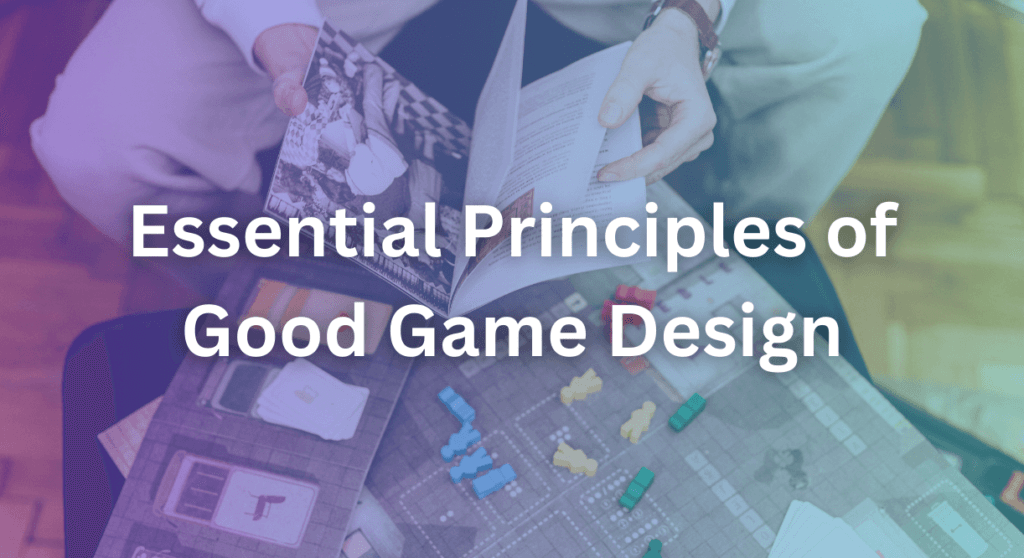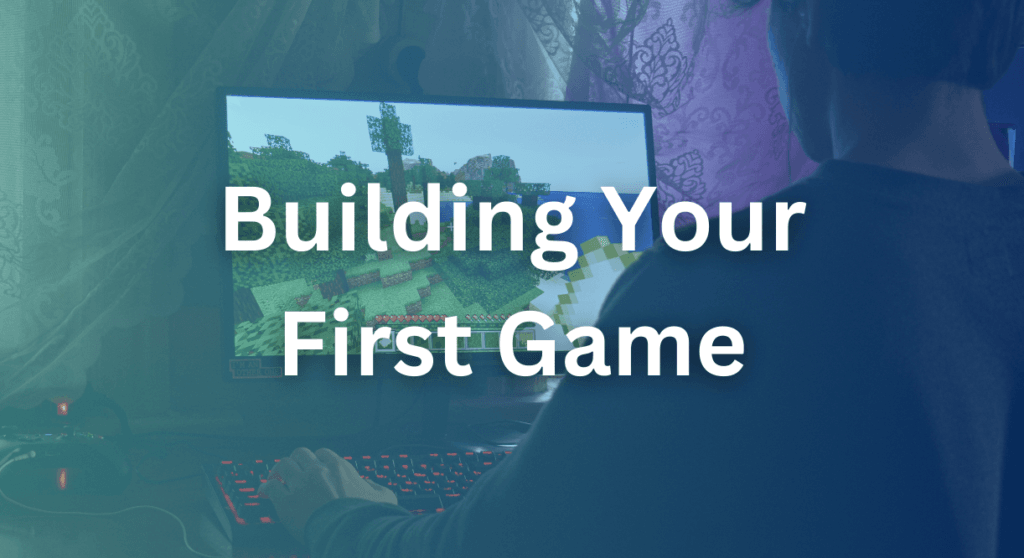Understanding Game Design Basics: A Beginner’s Guide
Game design Basics : Game design is a fascinating and dynamic field that blends creativity, storytelling, technology, and psychology. If you’ve ever dreamed of creating your own video games or simply want to understand how they work, this guide is for you.
Table of Contents
What is Game Design?
Game design is the art and science of creating the content and rules for games, including video games, board games, and role-playing games. Game design Basics involves defining how the game will play, what the objectives will be, and how players will interact with the game world.
Essential Principles of Good Game Design

Creating a successful game involves understanding several fundamental principles:
1. Player-Centric Design
Good game design starts with the player. This means understanding who your target audience is and what they enjoy. Consider the following:
- What motivates your players?
- What challenges do they enjoy?
- What types of stories resonate with them?
By answering these questions, you can create a game that not only attracts players but also keeps them engaged, and understanding Game design Basics will help to achieve your goal.
2. Core Mechanics
Every game should revolve around a central mechanic or gameplay concept. This is the action that players will repeat throughout the game.
Examples:
- In Pac-Man, the core mechanic is navigating a maze and collecting dots while avoiding ghosts.
- In Minecraft, it’s about building and exploring in a blocky world.
Choosing a strong core mechanic is essential for keeping players engaged and this is the core concept of Game design Basics.
3. Challenge and Reward Balance
A good game strikes a balance between challenge and reward. If a game is too easy, players may get bored; if it’s too difficult, they may become frustrated. Here’s how to achieve this balance:
- Gradually increase difficulty as players progress.
- Provide rewards for overcoming challenges, such as new abilities, levels, or in-game currency.
This keeps players motivated and encourages them to keep playing, understanding this will strong your Game design Basics.
4. Clarity and Learning Curve
Games should be easy to understand and learn. Here are some tips for achieving this:
- Introduce mechanics gradually: Start with the basics and layer in complexity as players become more comfortable.
- Use clear instructions and feedback: Make sure players understand the rules and objectives.
This helps avoid overwhelming players and encourages them to keep playing.
5. Storytelling and Theme
A compelling narrative can significantly enhance the gaming experience. A good story gives context to the gameplay and can deepen emotional engagement. Consider the following elements:
- Characters: Who are the players in your game?
- Setting: Where does the game take place?
- Conflict: What challenges do the characters face?
Crafting a well-rounded story can elevate your game from good to great.
6. Iterative Testing and Feedback
Game design is an iterative process. This means you should constantly test and refine your game based on player feedback. Here’s how to approach it:
- Prototype early: Create a basic version of your game to test ideas.
- Playtest: Get feedback from players to identify what works and what doesn’t.
This process helps you improve your game before the final release.
7. Visual and Audio Design
The aesthetic aspects of a game—graphics, art style, and sound—play a significant role in player immersion. Consider the following:
- Art Style: What visual style fits your game’s theme?
- Sound Design: How does the audio enhance the gameplay experience?
A cohesive visual and audio design can draw players into your game world.
Building Your First Game

Now that you have an understanding of game design principles and Game design Basics, let’s discuss how to start building your first game. Here’s a step-by-step guide:
Step 1: Develop an Interesting Game Concept
Begin by brainstorming ideas for your game. Ask yourself:
- What genre will it be? (e.g., action, adventure, RPG)
- What is the core mechanic?
- What story or theme will you explore?
Record all your ideas in a Game Design Document (GDD) to keep everything organized, which can be a good practice for Game design Basics.
Step 2: Create a Game Design Document (GDD)
A GDD is a living document that outlines all aspects of your game. It should include:
- Game Concept: What is the game about?
- Genre: What type of game is it?
- Story and Characters: Who are the main characters and what is the plot?
- Core Mechanics: What are the main actions players will take?
- Gameplay: How will the player interact with the game?
- Art and Design: What visual style will you use?
- Monetization Strategy: How will you generate revenue?
Having a GDD helps clarify your vision and serves as a roadmap for development.
Step 3: Learn Basic Game Design Principles
To build a great game, you need to understand basic game design principles:
- Focus on one core mechanic: This will help you create a focused and engaging experience.
- Make it easy to understand: Use simple rules and introduce new mechanics gradually.
- Offer regular rewards: This keeps players motivated and engaged.
Step 4: Determine Software and Skills You Need
Depending on the complexity of your game, you may need to learn certain skills and use specific software. Here are some popular game engines to consider:
- Unity: Great for beginners and widely used in the industry.
- Unreal Engine: Offers advanced graphics and is popular for high-quality games.
- GameMaker Studio: Excellent for 2D games and user-friendly.
- Godot: Open-source and versatile for various types of games.
You may also want to learn some programming languages. Here are a few common ones:
- C#: Often used with Unity.
- C++: Used in Unreal Engine and many other games.
- Python: Good for beginners and useful for game scripting.
Step 5: Start Building Your First Game!
Now comes the fun part: building your game! Remember to keep the following in mind:
- Start small: If this is your first game, don’t aim for something too complex. A simple project will help you learn and gain experience.
- Get feedback: Share your prototype with friends and family to gather their thoughts and improve your game.
- Iterate: Use feedback to make adjustments and enhance your game.
Game Design vs Game Development: What’s the Difference?
Explore the key differences between game design and game development. Learn how each role contributes to the creation of video games and what skills are needed, below there is Game design vs Game development.
How Does Game Design Differ from Game Development?
While game design focuses on the conceptual aspects—like gameplay mechanics, storytelling, and player experience—game development encompasses the entire process of building a game. This includes:
- Game Design: Conceptualizing gameplay mechanics, story, characters, and overall experience.
- Programming: Writing the code that makes the game function.
- Art and Animation: Creating the visual elements that players see, including characters, environments, and user interfaces.
- Sound Design: Crafting the audio elements, including music, sound effects, and voiceovers.
- Testing: Ensuring the game works correctly and is enjoyable to play.
In short, game design is a crucial part of game development, but it is just one piece of a much larger puzzle.
Game Design vs. Game Development

Game Design vs Game Development
Game Design
Game design primarily focuses on the conceptualization and planning stages of a game. Designers work on various aspects, including:
- Gameplay Mechanics: How the game is played and what actions the player can take.
- Story and Characters: The narrative arc and character development within the game.
- User Experience: Ensuring that players find the game intuitive and enjoyable.
- Level Design: Creating the game environment and how players interact with it.
Game designers often use tools like storyboards and game design documents to map out their ideas.
Game Development
Game development is the broader process that includes game design but also covers the actual building of the game. This can involve:
- Programming: Writing the code that brings the game to life.
- Art Production: Creating graphics, animations, and visual effects.
- Sound Production: Developing audio elements like music and sound effects.
- Quality Assurance: Testing the game to find and fix bugs.
Developers often specialize in specific areas, such as programming, art, or sound, and work collaboratively to bring the game from concept to final product.
In summary, while game design is focused on creating the vision for the game, game development encompasses all the steps required to make that vision a reality, now you have got the idea of game design vs game development.
Game Designer Salary: What to Expect by Experience Level
Find out how much game designers earn based on experience. This guide breaks down game designer salary ranges and provides insights into career growth in the gaming industry.
Salaries by Experience Level
The earnings of game designers and developers can vary widely based on their roles, experience, and location. Here’s a general overview of what you can expect game designer salary and game developer salary:
- Entry-Level (0-1 Year):
- Game Designer: $40,000 – $55,000
- Game Developer: $45,000 – $60,000
- Early Career (1-4 Years):
- Game Designer: $55,000 – $70,000
- Game Developer: $60,000 – $80,000
- Mid-Career (5-9 Years):
- Game Designer: $70,000 – $90,000
- Game Developer: $80,000 – $100,000
- Experienced (10-19 Years):
- Game Designer: $90,000 – $110,000
- Game Developer: $100,000 – $120,000
- Senior-Level (20+ Years):
- Game Designer: $110,000+
- Game Developer: $120,000+
These figures can vary based on factors such as the size of the studio, the geographic location, and the specific technologies or platforms involved.
How to Build a Portfolio for Game Design and Development
Learn how to create an impressive game design portfolio that showcases your skills. Discover essential projects and strategies to stand out in the competitive gaming industry, building a game design portfolio can be much harder, but you can refer below to create one.
For Game Designers
- Start with Personal Projects: Begin by designing your own games, even if they are small. Use tools like Unity or GameMaker Studio to create prototypes.
- Create a Game Design Document (GDD): Include your best ideas, mechanics, and narratives. This showcases your thought process and ability to plan.
- Participate in Game Jams: Join events like Ludum Dare or Global Game Jam to create games under time constraints. These experiences provide great material for your portfolio.
- Showcase Your Work Online: Use platforms like itch.io or your personal website to display your games. Include videos, screenshots, and detailed descriptions.
- Write Articles or Blogs: Share insights about your design process or analysis of existing games. This can demonstrate your knowledge and passion for the field.
For Game Developers
- Develop Sample Projects: Build small games or tools that showcase your programming skills. Include a variety of genres and mechanics.
- Contribute to Open Source Projects: Engaging with open-source games can help you gain practical experience while showcasing your ability to collaborate with others.
- Create a GitHub Repository: Share your code and projects on GitHub to demonstrate your technical skills. Include well-documented code to highlight your professionalism.
- Engage in Online Communities: Participate in forums like Stack Overflow or Reddit’s r/gamedev. Sharing your knowledge and helping others can build your reputation.
- Network with Industry Professionals: Attend game development conferences, meetups, and webinars to connect with others in the field. Networking can lead to collaboration opportunities and job offers.
Essential Skills for Game Designers: What You Need to Succeed
Essential Skills for Game Designers : Becoming a successful game designer requires a blend of creativity, technical expertise, and an understanding of player experiences. Here are the key skills every game designer should develop:
- Creativity and Artistic Vision: The ability to conceptualize unique gameplay, art, and compelling narratives.
- Understanding of Game Mechanics: Knowledge of core gameplay loops, balancing, and feedback systems.
- Programming Skills: Familiarity with languages like C++, C#, and Python to enhance game development.
- Technical Proficiency: Experience with game engines (e.g., Unity, Unreal Engine) and design software (e.g., Blender, Photoshop).
- Problem-Solving Skills: Analytical thinking and the ability to iterate and collaborate effectively.
- Communication Skills: Strong presentation abilities and receptiveness to feedback for successful teamwork.
- User Experience (UX) Design: Understanding player needs through testing and level design to enhance accessibility.
- Time Management: Project planning and prioritization skills to meet tight deadlines.
- Knowledge of Industry Trends: Keeping up with gaming trends and networking within the industry.
- Passion for Games: A genuine love for gaming that drives continuous learning and creativity.
By honing Essential Skills for Game Designers skills, aspiring game designers can create engaging and memorable gaming experiences while navigating the dynamic landscape of the gaming industry.
FAQs: Common Questions from Newbies
1. Do I need a degree to become a game designer?
No, a degree is not strictly necessary, but it can be beneficial. Many successful game designers have degrees in fields like computer science, graphic design, or game design. However, self-taught individuals can also find success through practice and experience.
2. What skills do I need to become a game designer?
Essential skills include creativity, problem-solving, teamwork, and communication. Familiarity with programming languages, art skills, and a strong understanding of game mechanics are also important.
3. Can I learn game design online?
Absolutely! There are numerous online courses, tutorials, and resources available for aspiring game designers. Platforms like Coursera, Udemy, and YouTube offer a wealth of information.
4. What programming languages should I learn?
Popular languages for game design include C#, C++, and Python. C# is widely used in Unity, while C++ is common in Unreal Engine. Python is great for beginners and useful for scripting.
5. How long does it take to create a video game?
The time it takes to create a game can vary widely based on its complexity. Simple games can take a few weeks or months, while more complex projects can take years.
6. What tools do I need to get started?
You’ll need a game engine (like Unity or Unreal Engine), a computer, and possibly graphic design software (like Adobe Photoshop or Blender). Basic programming knowledge will also be helpful.
7. Can I create a game by myself?
Yes, many indie developers create games solo. However, keep in mind that it can be a lot of work. If you have the resources, consider collaborating with others to share the workload.
8. What are some common game genres?
Some common game genres include action, adventure, role-playing games (RPGs), simulation, strategy, puzzle, and sports games. Understanding different genres can help you decide which type of game to create.
9. How do I get my game published?
Once your game is complete, you can self-publish through platforms like Steam, itch.io, or the App Store. You can also pitch your game to publishers if you’re looking for wider distribution and marketing support.
10. What should I do if I get stuck while designing my game?
If you encounter challenges, take a break and return with fresh eyes. Seeking feedback from others can also provide new perspectives. Online forums and communities can be helpful for advice and support.
Conclusion
Game design is an exciting and rewarding field that allows you to combine creativity and technology. By understanding the principles of good game design and following the steps outlined in this guide, you can start your journey into the world of game creation. Whether you aspire to develop a simple mobile game or a complex AAA title, the key is to stay curious, keep learning, and most importantly, have fun!
As you embark on this journey, remember that every great game starts with a single idea. Embrace the challenges, learn from your mistakes, and enjoy the process of bringing your vision to life. Happy designing!
















Pingback: Game Development Skills Every Beginner Needs to Succeed
Pingback: Exploring Different Roles in the Gaming Industry
Pingback: Best Practices for Killer Game Level Design